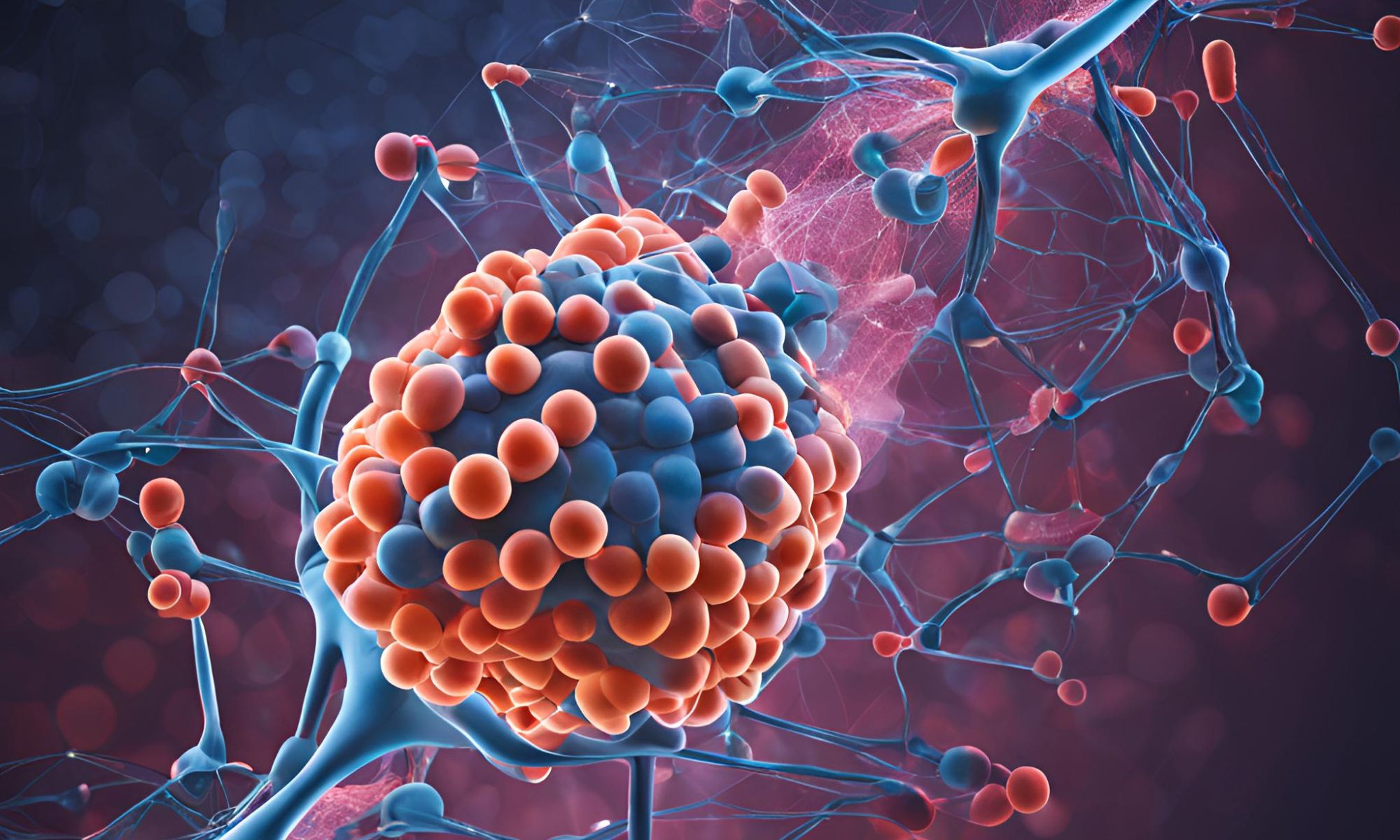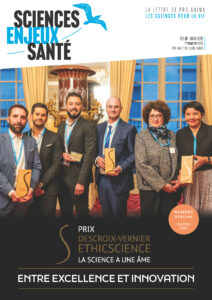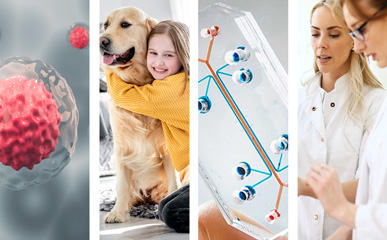
Tackling AI challenges in drug discovery, How hearts-on-chips can save millions, Revolutionary high-speed 3D bioprinter and more
News on non-animal methods
NOV 11 - 15, 2024NEWS, REPORTS & POSITION STATEMENTS
1. VICT3R : New European project aims to reduce animal testing using AI
Launched in September, the VICT3R project (Virtual Control animals 3R) will analyze historical data from pharmaceutical companies to create synthetic virtual animals using generative AI and machine learning ; a groundbreaking initiative coordinated by MELIS-UPF to reduce the use of laboratory animals by up to 25% in drug safety testing.
By reducing reliance on animal testing, the project addresses ethical concerns and can lower research costs, as animal studies are significantly more expensive than in vitro or in silico methods. The ultimate goal is to gain approval from regulatory bodies to use virtual control groups in safety evaluations of new drugs and chemicals, potentially changing the regulatory paradigm.
2. Breakthrough technologies and applications in Organ-on-a-Chip
Organ-on-a-chip technology has rapidly gained prominence and relevance at the interface between biology and engineering due to its burgeoning potential to revolutionize biomedical research and clinical applications. These micro-engineered devices mimic the physiological functions of human organs, providing powerful microfluidic platforms for disease modeling, drug testing and therapeutics, and personalized medicine.
The Royal Society of Chemistry journal opened a Thematic Collection, that aims to highlight the most innovative and ground-breaking advancements in Organ-on-a-Chip technology and applications at the forefront of the field.
3. Elsevier supports Pistoia Alliance to tackle AI challenges in drug discovery
Elsevier has announced its support for the Pistoia Alliance, a non-profit organization dedicated to dismantling systemic barriers to innovation in life sciences, through a joint program of events. Founded by AstraZeneca, GSK, Novartis, and Pfizer, the Pistoia Alliance fosters pre-competitive collaboration among life sciences companies, tech providers, academic institutions, and publishers. This alliance aims to address persistent challenges in artificial intelligence.
Mirit Eldor, Managing Director at Elsevier, articulates the centrality of data credibility within AI-powered research : “The Pistoia Alliance provides an invaluable platform for collective expertise. By harnessing shared knowledge and advancing best practices, we can tackle the fundamental data challenges inhibiting AI’s potential to accelerate safe, effective therapies.”
INTERVIEWS, NOMINATIONS & AWARDS
4. How hearts-on-chips can save millions
Every year, cardiovascular disease impacts over 126 million people worldwide. In the quest for effective treatments, researchers are tirelessly working to develop better solutions. However, current animal and test-tube models often fall short in predictive accuracy. Prof. Dr. Robert Passier is at the forefront of this research, combining advanced technologies to create innovative human heart models that function like real human hearts.
Discover how hearts-on-chips can transform cardiovascular disease treatment, reducing reliance on animal testing while advancing innovative human heart models.
Read more and watch the interview
TOOLS, PLATFORMS, CALLS
5. ANR is setting up European or International Scientific networks — SRSEI 2024
In the framework of its 2024 Work Programme, the French National Research Agency (ANR) proposes the SRSEI call with a continuous submission format throughout the year.Through SRSEI call, researchers working in French laboratories should have easier ability to apply to European programmes (Horizon Europe) and other international calls in two steps and thus have the opportunity to lead ambitious transnational networks.
Funding will only be provided for research networks, in all the disciplines, and that have specifically been set up to submit a collaborative project in response to a large-scale European or international two steps call for proposals with major scientific, technological or societal impacts.
6. The e‑Flower : A hydrogel-actuated 3D MEA for brain spheroid electrophysiology
Traditional microelectrode arrays (MEAs) are limited to measuring electrophysiological activity in two dimensions, failing to capture the complexity of three-dimensional (3D) tissues such as neural organoids and spheroids.
A new research article introduces a flower-shaped MEA (e‑Flower) that can envelop submillimeter brain spheroids following actuation by the sole addition of the cell culture medium. Inspired by soft microgrippers, its actuation mechanism leverages the swelling properties of a polyacrylic acid hydrogel grafted to a polyimide substrate hosting the electrical interconnects. Compatible with standard electrophysiology recording systems, the e‑Flower does not require additional equipment or solvents and is ready to use with 3D tissues. The authors demonstrated the ability of the e‑Flower to detect spontaneous neural activity across the spheroid surface, demonstrating its potential for comprehensive neural signal recording.
Read the article in Science Advances
7. Revolutionary high-speed 3D bioprinter hailed a gamechanger for drug discovery
Biomedical engineers from the University of Melbourne have invented a 3D printing system, or bioprinter, capable of fabricating structures that closely mimic the diverse tissues in the human body, from soft brain tissue to harder materials like cartilage and bone. This cutting-edge technology offers researchers an advanced tool for replicating specific organs and tissues, significantly improving the potential to predict and develop new pharmaceutical therapies. This would pave the way for more advanced and ethical drug discovery by reducing the need for animal testing.
Head of the Collins BioMicrosystems Laboratory at the University of Melbourne, Associate Professor David Collins said : “In addition to drastically improving print speed, our approach enables a degree of cell positioning within printed tissues. Incorrect cell positioning is a big reason most 3D bioprinters fail to produce structures that accurately represent human tissue.”
INDUSTRY, BIOTECH & PARTNERSHIPS
8. Iambic Therapeutics unveils Enchant AI to predict clinical outcomes using (pre)clinical data
Iambic Therapeutics has announced the launch of Enchant, an AI platform designed to predict clinical outcomes from the earliest stages of drug discovery. Enchant is a multi-modal transformer model that aims to address a critical bottleneck in drug development by utilizing preclinical data to improve predictions about clinical outcomes, even when clinical data is limited. The model is trained across numerous data modalities and sources, spanning the full drug discovery and development process.
“Bringing a drug to market often costs billions, partly because critical pharmacological insights aren’t uncovered until human trials are well underway. […] When trained on the full set of available human clinical PK data, Enchant’s clinical predictions surpass all state-of-the-art models. But most critically the model gets better at predicting clinical outcomes by training on more laboratory data.” Fred Manby, PhD, Iambic’s Chief Technology Officer.
9. Quris-AI acquires Nortis to enhance drug safety with kidney-on-chip tech
Quris-AI, a company dedicated to enhancing drug safety prediction, has announced its acquisition of Kidney-on-Chip pioneer Nortis, also known as Numa Biosciences, Inc. Nortis’s Kidney-on-Chip technology, recognized by the National Institutes of Health’s National Center for Advancing Translational Sciences (NCATS), is widely regarded for advancing in-vitro testing standards for precision in drug development.
Its platform, leveraging 3D physiologically relevant organ models and genetically diverse stem-cell-derived tissue data, aims to provide a refined predictive approach to model human responses, with the goal of enhancing accuracy and efficiency in the drug development process.
SCIENTIFIC DISCOVERIES & PROTOCOLS
10. Discovery of a new prognostic biomarker in head and neck squamous cell carcinomas
Patients with head and neck squamous cell carcinomas (HNSCC) often have poor outcomes due to suboptimal risk management and treatment strategies ; yet integrating novel prognostic biomarkers into clinical practice is challenging.
Researchers from Institut Gustave Roussy reported the presence of multinucleated giant cells (MGC) — a type of macrophages — in tumors from patients with HNSCC, which are associated with a favorable prognosis in treatment-naive and preoperative chemotherapy – treated patients. To enable clinical translation of MGC density as a prognostic marker, they developed a deep-learning model to automate its quantification on routinely stained pathological whole slide images. They also used spatial transcriptomic and proteomic approaches to describe the MGC-related tumor microenvironment and observed an increase in central memory CD4 T cells.
Read more (FR)
Read the publication in Cancer Discovery
11. Human midbrain organoids : A promising tool in the fight against Parkinson’s disease
Parkinson’s Disease (PD) is a common neurodegenerative disorder affecting over 6.1 million people globally, characterized by motor symptoms like tremors, slow movement, and rigidity, as well as non-motor issues such as depression and cognitive decline. Further research is needed to develop better human-relevant models to understand PD mechanisms and improve treatment options.
In a recent review published in the npj Parkinsons Disease, the authors explored the use of human midbrain organoids (mini 3D organ models) in PD research, drug screening, and therapy, highlighting challenges and optimization strategies.
Read the publication in npj Parkinsons Disease
12. Hope for personalized therapies : Scientists uncover two Crohn’s disease subtypes using lab-grown intestines
Crohn’s disease (CD) is a long-lasting digestive illness with varying symptoms among different individuals. Inflammation drives pathologic changes in CD, which is multifactorial in origin. There is currently no perfect way to study CD before testing on humans, and there is no cure. A significant challenge is the lack of a reliable preclinical model that replicates human disease complexity.
In a recent study published in the journal Cell Reports Medicine, researchers created small, laboratory-grown intestine organoids, from tissue samples of patients with Crohn’s Disease (CD) to characterize their phenotypic and genotypic features. The team performed high-throughput techniques, including single-cell and RNA sequencing analysis. The study highlights the molecular and phenotypic heterogeneity of CD subtypes that could explain the differing severity of CD symptoms among individuals. The findings also showcase the utility of PDOs in studying patient-specific responses to therapies and identifying genes and drugs that could improve CD diagnosis and management.
Read the publication in Cell Reports Medicine


